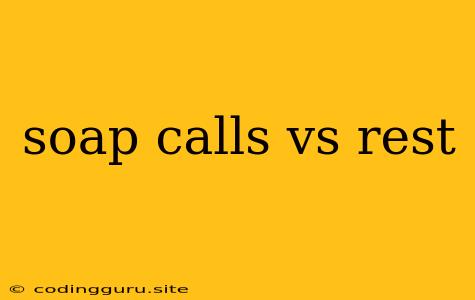SOAP Calls vs REST: Which API Architecture is Right for You?
In the realm of software development, APIs (Application Programming Interfaces) serve as the bridge between different applications, enabling seamless communication and data exchange. Two prominent API architectures, SOAP and REST, have emerged as popular choices for developers.
What are SOAP Calls and REST?
- SOAP (Simple Object Access Protocol): A protocol built on XML (Extensible Markup Language) for exchanging structured data between applications. It utilizes a complex, message-based approach, where requests and responses are encapsulated within XML envelopes.
- REST (Representational State Transfer): An architectural style that leverages HTTP (Hypertext Transfer Protocol) for communication. REST APIs employ a stateless approach, relying on standardized HTTP methods like GET, POST, PUT, and DELETE for resource manipulation.
Key Differences Between SOAP Calls and REST
Understanding the differences between SOAP Calls and REST can help you choose the best fit for your project. Here's a breakdown of their key characteristics:
1. Communication Protocol:
- SOAP: Utilizes XML for message formatting and relies on protocols like HTTP or SMTP for transmission.
- REST: Relies on HTTP for both message formatting and transmission.
2. Data Format:
- SOAP: Primarily uses XML for data representation.
- REST: Supports various data formats, including XML, JSON (JavaScript Object Notation), plain text, and others.
3. Architecture:
- SOAP: Follows a complex, message-based architecture, requiring strict adherence to specific rules and conventions.
- REST: Adopts a stateless architecture, where each request is independent and self-contained.
4. State Management:
- SOAP: Can be stateful or stateless, depending on implementation.
- REST: Strictly stateless, requiring client-side management of any required state information.
5. Security:
- SOAP: Built-in security features through WS-Security, which provides mechanisms like encryption and authentication.
- REST: Security is implemented at the application level, leveraging mechanisms like OAuth 2.0 or JWT (JSON Web Token).
6. Complexity:
- SOAP: Generally considered more complex due to its XML-based message format and strict standards.
- REST: Relatively simpler due to its use of standard HTTP methods and flexibility in data format.
7. Scalability:
- SOAP: May face scalability challenges due to its inherent complexity and reliance on heavyweight XML parsing.
- REST: Often more scalable due to its stateless nature and utilization of lightweight HTTP protocols.
When to Choose SOAP Calls vs REST
The choice between SOAP Calls and REST ultimately depends on your specific requirements and project context:
Choose SOAP Calls when:
- High security is paramount: SOAP's built-in WS-Security features offer robust security mechanisms.
- Complex transactions are involved: SOAP's message-based architecture can handle intricate workflows with multiple steps.
- Existing SOAP infrastructure is already in place: Leveraging existing SOAP infrastructure can be more efficient.
Choose REST when:
- Simplicity and ease of use are prioritized: REST's minimalist approach and lightweight communication make it easier to implement.
- Flexibility in data formats is desired: REST supports various data formats, allowing for better integration with different systems.
- Scalability and performance are critical: REST's stateless nature and HTTP-based communication generally provide better scalability and performance.
Examples:
- SOAP: Web services for financial transactions, where security and complex workflows are critical.
- REST: APIs for social media platforms, e-commerce platforms, and cloud services, where simplicity, flexibility, and scalability are essential.
Tips for Choosing the Right Architecture:
- Evaluate your specific needs: Consider factors like security, complexity, data formats, and scalability.
- Consider your development team's experience: Choose an architecture that your team is familiar with and comfortable working with.
- Research industry best practices: Explore how other companies in your industry are using APIs to gain insights.
Conclusion
Both SOAP Calls and REST offer valuable features for API development. SOAP provides a robust and secure framework, while REST offers simplicity, flexibility, and scalability. By carefully analyzing your project requirements and considering the advantages and disadvantages of each architecture, you can make an informed decision and choose the API architecture that best suits your needs.
